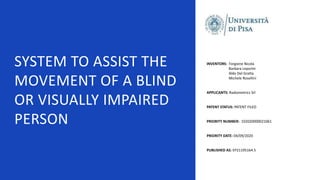
Assist Blind Navigation with Haptic Signals
- 1. SYSTEM TO ASSIST THE MOVEMENT OF A BLIND OR VISUALLY IMPAIRED PERSON INVENTORS: Forgione Nicola Barbara Leporini Aldo Del Gratta Michele Rosellini APPLICANTS: Radiometrics Srl PATENT STATUS: PATENT FILED PRIORITY NUMBER: 102020000021061 PRIORITY DATE: 04/09/2020 PUBLISHED AS: EP21195164.5
- 2. The proposed technology is a multifunctional device that can communicate different information to blind and visually impaired people via body-perceptible haptic signals: • indicate the presence of obstacles in the proximity of the person, • distinguish obstacles by direction (left and right) and proximity (different intensity and frequency). • inform the user whether an environment is illuminated or not. • interface with other devices, such as smartphones or smartwatches, that via appropriate app will be used to guide the user to a destination, taking advantage of interactive Google Maps, for example. However, the device will be usable by any app that needs to communicate information and notifications to the user that can be encoded via haptic signals. The device allows for better orientation in both indoor and outdoor environments. The device is adapted to any eyeglass frame and will produce a vibration that can be felt by the body to give information, leaving the auditory channel available for perception of the surroundings. Invention
- 4. Innovative haptic, adaptive and multifunctional technology can be easily used by blind and visually impaired children, adults and the elderly for their orientation and mobility. Therefore, the proposed technology could be used by external devices as an output interface to communicate information to the person, in a variety of contexts. For example, the device could be useful for guiding a patient in a hospital or other public institution, or in work situations (thus falling under Industry 4.0 technologies), as a support to avoid collisions between the worker and a nearby moving machinery. A blind person's daily needs include being able to detect an obstacle (obstacle detection mode) and being able to be guided with some ease to a specific destination (navigation mode). It is possible to prepare the device for audio feedback with the integration of bone-conduction earphones to provide specific information that is non-invasive during the most critical phases of mobility. Industrial applications
- 5. Possible developments The technology detects obstacles at a distance via ultrasonic sensors and communicates that distance, and direction between right/left, to the user via haptic actuators (vibrating devices) placed on the supporting rods, leaving the ear canal free, as well as the hands, which can thus be used to take advantage of a white cane or guide-dog. Such glasses can also distinguish between distant obstacles (up to 8 meters) and proximity obstacles (< 2 meters). Specifically, for distant obstacles, the system can also indicate whether the obstacle is on the left or right side, while for proximity obstacles the detection is frontal and is communicated to the user by vibration of the nasal support of the glasses. Future implementation of the system will take place through stand-alone devices that can be attached to any eyeglass frame through appropriate mounting kits, which will allow the replacement of only one part of the device in case of its malfunction. The research team is interested in collaborating with industrial partners and considering licensing or transferring the patented invention for commercialization by interested companies. Watch the video of the technology at www.youtube.com/watch?v=c9-dvO8uyZI
- 6. For more information: Ufficio Regionale di Trasferimento Tecnologico Sede: Via Luigi Carlo Farini, 8 50121 Firenze (FI) E-mail: urtt@regione.toscana.it For more information: Tech Transfer Office of University of Pisa Headquarters: Lungarno Pacinotti 43/44, Pisa (PI) 56126 Web site: www.unipi.it/index.php/trasferimento E-mail: valorizzazionericerca@unipi.it
